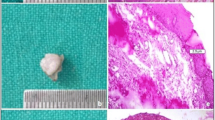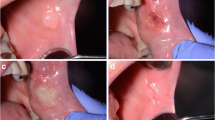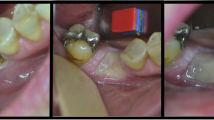Abstract
Hyperplastic fibro-epithelial lesions are the most common tumor-like swellings in the mouth. The neodymium yttrium aluminium garnet (Nd:YAG) laser appears to be useful for the surgical treatment of these lesions. Some controversies of laser surgery concern the accuracy of pathological diagnosis as well as the control of thermal damage on the target tissue. The aim of this study was to establish if the thermal changes induced by the Nd:YAG laser may affect the histopathological diagnosis and the evaluation of the resection margins. Furthermore, we compared the histological features of oral benign fibro-epithelial lesions excised through Nd:YAG laser and traditional scalpel. Twenty-six benign fibro-epithelial oral lesions from 26 patients, localized in the same oral subsites (cheek and buccal mucosa), were collected at the Unit of Oral Pathology and Oral Laser-assisted Surgery of the Academic Hospital of the University of Parma, Italy. Specimens were subclassified into three groups according to the tool used for the surgical excision. Group 1 included six specimens excised through Nd:YAG laser with an output power of 3.5 W and a frequency of 60 Hz (power density 488,281 W/cm2); Group 2 included nine specimens excised through Nd:YAG laser with an output power of 5 W and a frequency of 30 Hz; Group 3 included 11 specimens excised through a Bard-Parker scalpel blade no. 15c. Epithelial changes, connective tissue modifications, presence of vascular modifications, incision morphology and the overall width of tissue modification were evaluated. Differences between specimens removed with two different parameters of Nd:YAG laser were not significant with regard to stromal changes (p = 0.4828) and vascular stasis (p = 0.2104). Analysis of regularity of incision revealed a difference which was not statistically significant (p = 1.000) between group 1 and group 2. Epithelial and stromal changes were significantly more frequent in specimens with a mean size less than 7 mm (p < 0.0001). Nd:YAG laser induced serious thermal effects in small specimens (mean size less than 7 mm) independently from the frequency and power employed. The quality of incision was better and the width of overall tissue injuries was less in the specimens obtained with higher frequency and lower power (group 1: Nd:YAG laser at 3.5 W and 60 Hz).






Similar content being viewed by others
References
Rocca J-P: Les laser en odontologie. Editions CdP-Wolters Kluver France-Avril 2008
Wenig BM (2008) Atlas of head and neck pathology, 2nd edn. Saundeish Elsevier, China
Fletcher Christopher DM (2007) Diagnostic histopathology of tumors, 3rd edn. Churchill Livingston–Elsevier, China
Clayman L, Kuo P (1997) Lasers in Maxillofacial Surgery and Dentistry. Thieme Medical Publishers, USA
Svelto O (1998) Principles of Lasers, 4th edn. Springer Sciences–Business Media Inc, USA
Niemz MH (2004) Laser-tissue interactions. Fundamental applications, 3rd edn. Springer-Verlag, Berlin Heidelberg Germany
Vesnaver A, Dovŝak DA (2006) Treatment of vascular lesions in the head and neck using Nd:YAG laser. J Cranio Maxillofac Surg 34:17–24
Reimer SB, Sequin B, Hilde HD et al (2005) Evaluation of the effect of routine histologic processing on the size of skin samples obtained from dogs. Am J Vet Res 66:500–505
Silveberg SG (2006) Surgical Pathology and cytopathology, 4th edn. Churchill Livingston–Elsevier, China
Yukna RA, Carr RL, Evans GH (2007) Histologic evaluation of an Nd:YAG laser-assisted new attachment procedure in humans. Int J Periodontics Restorative Dent 27(6):577–587
Howell R, Hammond R, Pryse-Davies J (1991) The histologic reliability of laser come biopsy of the cervix. Obstet Gynecol 77:905–911
Lewis PL, Lasghari M (1994) A comparison of the cold knife, CO2 laser and electrosurgical loop conization in the treatment of cervical intraepithelial neoplasia. J Gynecol Surg 10:905–911
Spencer P, Coob CM, Weliczka DM, Glaros A, Morris P (1998) Change in temperature of subjacent bone during soft tissue laser ablation. J Periodontol 69:287–291
Parker S (2007) Laser and soft tissue: “loose” soft tissue surgery. Br Dent J (4):185–191. Feb202
Fornaini C, Rocca JP, Bertrand MF, Merigo E, Nammour S, Vescovi P (2007) Nd:YAG and Diode laser in the surgical management of soft tissues related to orthodontic treatment. Photomed and Laser Surg 25(5):381–392
Nammour S, Dourov N (1992) Removal of benign tumors using CO2 laser. J Clin Laser Med Surg 4:109–113
Gutknecht N (2007) Proceedings of the 1st international workshop of Evidence-Based Dentistry on laser in dentistry. Quintessence Publishing Co Ltd, Chicago
Genovese MD, Olivi G (2008) Laser in paediatric dentistry: patient acceptance of hard and soft tissue therapy. Eur J Paediatr Dent 9(1):13–17
Taylor DL, Schafer S, Nordquist R, Payton ME, Dickley DT, Bartelas KE (1997) Comparison of a high power diode laser with the Nd:YAG laser using in situ wound strength analysis of healing cutaneous incisions. Laser Med Surg 21:248–254
Liboon J, Funkhouser W, Terris DJ (1997) A comparison of mucosal incisions made by scalpel, CO2 laser, electrocautery and constant-voltage electrocautery. Otolaryngol Head Neck Surg 116:379–385
Sinha UK, Gallagher LA (2003) Effects of steel scalpel, ultrasonic scalpel, CO2 laser and monopolar and bipolar electrosurgery on wound healing in Guinea pig oral mucosa. Laryngoscope 113(2):228–236
D’Arcangelo C, Di Nardo Di Maio F, Prosperi GD, Conte E, Baldi M, Caputi S (2007) A preliminary study of healing of diode laser versus scalpel incisions in rat oral tissue: a comparison of clinical, histological, and immunohistochemical results. Oral Surg Oral Med Oral Pathol Oral Radiol Endod 103(6):764–773
Author information
Authors and Affiliations
Corresponding author
Rights and permissions
About this article
Cite this article
Vescovi, P., Corcione, L., Meleti, M. et al. Nd:YAG laser versus traditional scalpel. A preliminary histological analysis of specimens from the human oral mucosa. Lasers Med Sci 25, 685–691 (2010). https://doi.org/10.1007/s10103-010-0770-4
Received:
Accepted:
Published:
Issue Date:
DOI: https://doi.org/10.1007/s10103-010-0770-4




